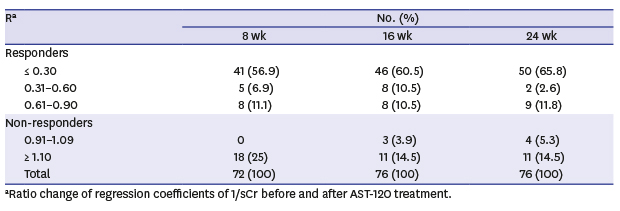4. Ritz E. Clinical manifestations and natural history of diabetic kidney disease. Med Clin North Am. 2013; 97(1):19–29.


5. Remuzzi G, Schieppati A, Ruggenenti P. Clinical practice. Nephropathy in patients with type 2 diabetes. N Engl J Med. 2002; 346(15):1145–1151.
6. Shepler B, Nash C, Smith C, Dimarco A, Petty J, Szewciw S. Update on potential drugs for the treatment of diabetic kidney disease. Clin Ther. 2012; 34(6):1237–1246.


7. Niwa T. Indoxyl sulfate is a nephro-vascular toxin. J Ren Nutr. 2010; 20(5):Suppl. S2–S6.

8. Niwa T. Targeting protein-bound uremic toxins in chronic kidney disease. Expert Opin Ther Targets. 2013; 17(11):1287–1301.


9. Akizawa T, Asano Y, Morita S, Wakita T, Onishi Y, Fukuhara S, et al. Effect of a carbonaceous oral adsorbent on the progression of CKD: a multicenter, randomized, controlled trial. Am J Kidney Dis. 2009; 54(3):459–467.


11. Schulman G, Berl T, Beck GJ, Remuzzi G, Ritz E, Arita K, et al. Randomized placebo-controlled EPPIC trials of AST-120 in CKD. J Am Soc Nephrol. 2015; 26(7):1732–1746.


12. Matthews DR, Hosker JP, Rudenski AS, Naylor BA, Treacher DF, Turner RC. Homeostasis model assessment: insulin resistance and beta-cell function from fasting plasma glucose and insulin concentrations in man. Diabetologia. 1985; 28(7):412–419.

13. Cockcroft DW, Gault MH. Prediction of creatinine clearance from serum creatinine. Nephron. 1976; 16(1):31–41.


15. Wilkinson CP, Ferris FL 3rd, Klein RE, Lee PP, Agardh CD, Davis M, et al. Proposed international clinical diabetic retinopathy and diabetic macular edema disease severity scales. Ophthalmology. 2003; 110(9):1677–1682.


16. Mitch WE, Walser M, Buffington GA, Lemann J Jr. A simple method of estimating progression of chronic renal failure. Lancet. 1976; 2(7999):1326–1328.

17. Sanaka T, Sugino N, Teraoka S, Ota K. Therapeutic effects of oral sorbent in undialyzed uremia. Am J Kidney Dis. 1988; 12(2):97–103.


18. Scott IA. Non-inferiority trials: determining whether alternative treatments are good enough. Med J Aust. 2009; 190(6):326–330.


19. Konishi K, Nakano S, Tsuda S, Nakagawa A, Kigoshi T, Koya D. AST-120 (Kremezin) initiated in early stage chronic kidney disease stunts the progression of renal dysfunction in type 2 diabetic subjects. Diabetes Res Clin Pract. 2008; 81(3):310–315.


20. Sanaka T, Akizawa T, Koide K, Koshikawa S. Protective effect of an oral adsorbent on renal function in chronic renal failure: determinants of its efficacy in diabetic nephropathy. Ther Apher Dial. 2004; 8(3):232–240.


21. Shimizu H, Okada S, Shinsuke OI, Mori M. Kremezin (AST-120) delays the progression of diabetic nephropathy in Japanese type 2 diabetic patients. Diabetes Care. 2005; 28(10):2590.

22. Niwa T, Ise M. Indoxyl sulfate, a circulating uremic toxin, stimulates the progression of glomerular sclerosis. J Lab Clin Med. 1994; 124(1):96–104.

23. Shoji T, Wada A, Inoue K, Hayashi D, Tomida K, Furumatsu Y, et al. Prospective randomized study evaluating the efficacy of the spherical adsorptive carbon AST-120 in chronic kidney disease patients with moderate decrease in renal function. Nephron Clin Pract. 2007; 105(3):c99–c107.

24. Yorioka N, Ito T, Masaki T, Ogata S, Asakimori Y, Tanji C, et al. Dose-dependent effect of an oral adsorbent, AST-120, in patients with early chronic renal failure. J Int Med Res. 2002; 30(5):467–475.


25. Schulman G, Berl T, Beck GJ, Remuzzi G, Ritz E, Shimizu M, et al. Risk factors for progression of chronic kidney disease in the EPPIC trials and the effect of AST-120. Clin Exp Nephrol. 2018; 22(2):299–308.


26. Ichikawa I, Kiyama S, Yoshioka T. Renal antioxidant enzymes: their regulation and function. Kidney Int. 1994; 45(1):1–9.


27. Hattori M, Nikolic-Paterson DJ, Miyazaki K, Isbel NM, Lan HY, Atkins RC, et al. Mechanisms of glomerular macrophage infiltration in lipid-induced renal injury. Kidney Int Suppl. 1999; 71:S47–S50.

28. Trevisan R, Dodesini AR, Lepore G. Lipids and renal disease. J Am Soc Nephrol. 2006; 17(4):Suppl 2. S145–S147.

29. Owada S, Goto S, Bannai K, Hayashi H, Nishijima F, Niwa T. Indoxyl sulfate reduces superoxide scavenging activity in the kidneys of normal and uremic rats. Am J Nephrol. 2008; 28(3):446–454.











 Citation
Citation Print
Print




 XML Download
XML Download